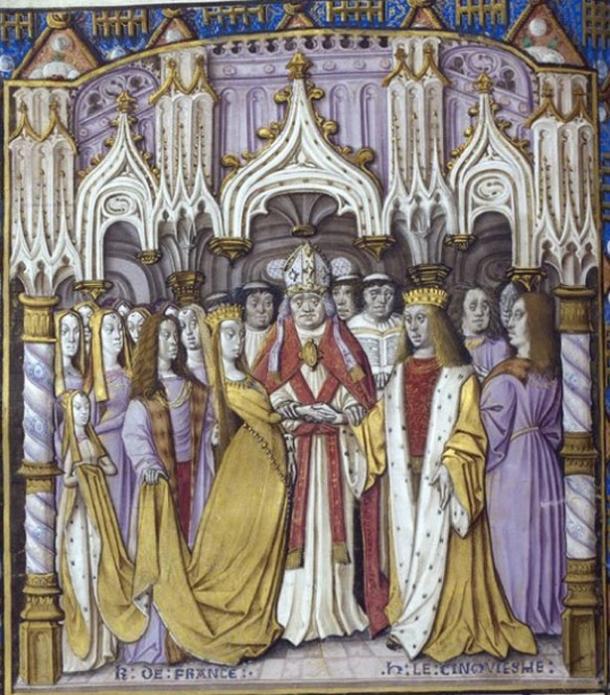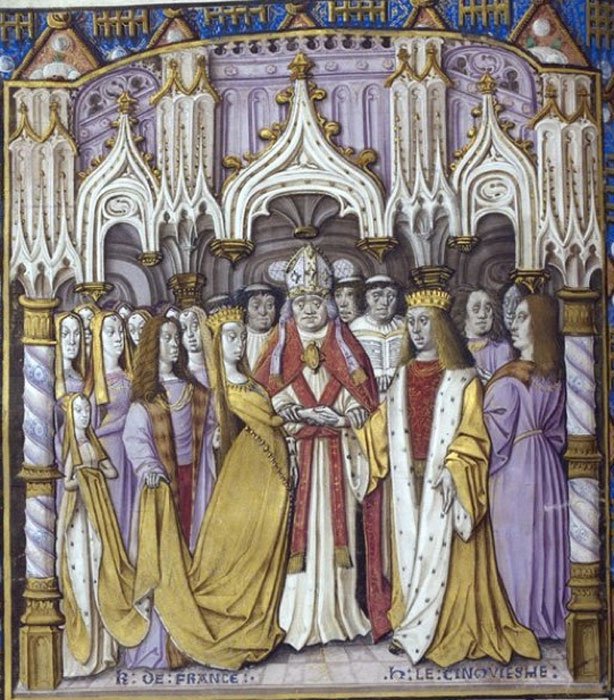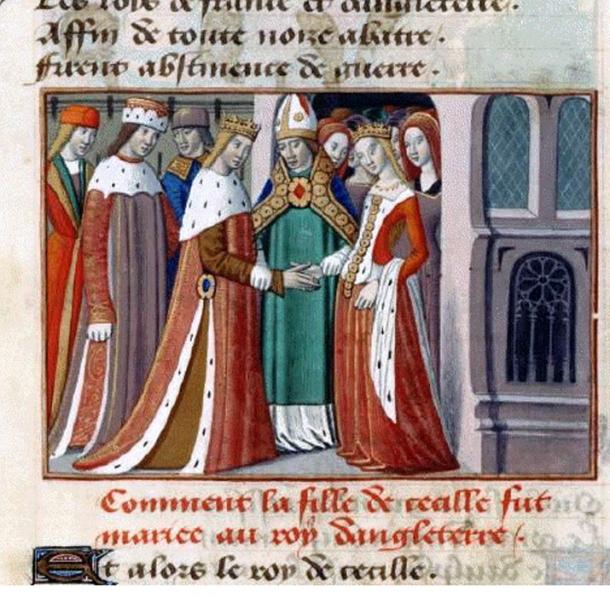The Hundred Years’ War was a series of conflicts (as opposed to a single, continuous war) fought between England and France. According to record, the war began in 1337 and ended in 1453 (a total of 116 years) and may be loosely divided into four phases.
The First Phase of the Hundred Years’ War
The first phase of the Hundred Years’ War lasted from 1337 to 1360. In 1328 Charles IV, the last Capetian king of France died without a male heir and was succeeded by Philip VI, the first French king of the House of Valois. Although Philip was Charles’ cousin, the latter’s closest male relative was in fact Edward III , the King of England (whose mother was Charles’ sister Isabella). Nevertheless, the French nobility accepted Philip as the new king as Edward was English and only 15 years old. Moreover, Edward had only been crowned the year before and therefore would have been occupied back home.
When Did the Trouble Begin?
Trouble began in 1337 when Philip confiscated Aquitaine and Ponthieu, Edward’s fiefs in France, as punishment for harboring Robert of Artois the French king’s cousin and enemy. Edward retaliated by challenging Philip’s right to the French throne, and in 1340, assumed the title ‘King of France and the French Royal Arms’. Edward formed alliances with discontented French nobles and provinces, who fought against the French king in France, causing much damage to the economy. Additionally, The English launched expeditions from time to time and three great victories, the Battles of Sluys (1340), Crécy (1346), and Poitiers (1356), were won by the English during this period.
The First Phase Ends with the Treaty of Brétigny
The first phase of the Hundred Years’ War ended with the Treaty of Brétigny , which favored the English. One of the conditions of the treaty was the return of Aquitaine to the English and when this territory was seized again by the French in 1369 war erupted once more. The second phase of the Hundred Years’ War lasted until 1400. By this time, Philip had died, and the reigning French king was Charles V. Thanks to Charles and his formidable commander, Bertrand du Guesclin, the French were able to regain most of the territory ceded to the English in 1360. Both the French king and his commander died in 1380 and by this time both sides had grown weary of the war. In the two decades that followed fighting had been sporadic and punctuated by truces.
The Second Phase of the Hundred Years’ War
The next phase of the war lasted from 1400 to 1429, during which the English made significant gains in France. This period is best-remembered in England for the Battle of Agincourt in 1415, during which Henry V inflicted a crushing defeat on a much larger pursuing French force. Two years later, the English returned to France and succeeded in conquering Normandy. In the meantime, France was divided between Burgundy and Orléans (whose allies were known as the Armagnacs), as the two factions competed for the control of the government. The French king, Charles VI, was insane and therefore was quite incapable of ruling.
Battle of Agincourt. (Antoine Leduc / Public Domain )
The Treaty of Troyes Leads to a Divided France
This division in France resulted in the signing of the Treaty of Troyes in 1420, which was brokered between Henry and Charles by Philip of Burgundy. The treaty recognized Henry, through his marriage to Charles’ daughter Catherine, as heir to the French throne while disinheriting Charles’ own son the future Charles VII. In return, the English would support the Burgundians against their war against the Armagnacs. Although the treaty was largely accepted in the north, it was not recognized in the south which was controlled by the Armagnacs among who was the Charles’ son.
Marriage of Henry V of England to Catherine. (enwiki / Public Domain )
The Succession of Throne is Disputed Once Again
Both Henry and Charles died in 1422 and the French throne passed to Henry VI, the infant son of the English king and Catherine. The succession, however, was disputed by Charles the late French king’s disinherited son. In the years that followed, the English fought successfully against the Armagnacs and in 1428 were besieging Orléans itself. The tide, however, began to turn against the English in the following.
The Third and Final Phase of the Hundred Years’ War
The final phase of the Hundred Years’ War lasted from 1429 to 1453. In 1429, a young French peasant girl by the name of Joan of Arc came into the service of the French dauphin Charles. She claimed that she was given a mission by God to rescue the dauphin and to deliver him to his coronation at Reims. She was sent to Orléans as part of a relief mission and nine days after her arrival the siege was lifted. Two months later, Joan had brought the French army to Reims and on the morning of the 17 th of July 1429, Charles VII was crowned in Reims Cathedral. In 1430 the Burgundians captured Joan and her handed over to the English, she was tried and burnt at the stake for witchcraft in 1431. Joan of Arc is considered a national heroine of France and one of the country’s patron saints.
Joan of Arc captured at Compiegne. ( Public Domain )
Stalemate Leads to Another Treaty
Charles VII fared less well after his coronation and the English were able to recapture some of the territories that had been lost to Joan of Arc. After several years of stalemate, the Congress of Arras was established in 1435 in order to negotiate peace. The congress was a diplomatic failure for the English as they left empty-handed. For the French, however, it was a victory since the singing of the Treaty of Arras brought the Burgundians to their side.
Negotiations and Fighting Continue
Although the war continued negotiations between the two sides continued. A general truce was attained in 1444 with the marriage of Henry VI to the French princess Margaret of Anjou. This fragile peace came to an end in 1449 when the English sacked and looted Fougères Brittany. During the period of peace, Charles VII reorganized his army and government thus allowing him to better fight the English. The French retook the lands lost to the English and by 1453 the only area still under English rule in France was Calais. The Hundred Years’ War did not end with a peace treaty. Instead, the English realized that the French army was now too strong to confront directly, abandoned their designs on France and effectively brought to war to an end.
The marriage of Henry VI and Margaret of Anjou. (histoire-fr.com / Public Domain )
Top image: On Left – The Battle of Crécy. On Right – Philip VI of France. Source Left, Public Domain ; Right, Public Domain .
By Wu Mingren
References
Cavendish, R., 2003. End of the Hundred Years War. [Online]
Available at: https://www.historytoday.com/richard-cavendish/end-hundred-years-war
History.com Editors, 2009. Hundred Years’ War. [Online]
Available at: https://www.history.com/topics/middle-ages/hundred-years-war
Keen, M., 2017. The Hundred Years War. [Online]
Available at: http://www.bbc.co.uk/history/british/middle_ages/hundred_years_war_01.shtml
Miller, M., 2018. England’s King Edward III’s Designs on the French Kingship Led to the Hundred Years War. [Online]. Available at: https://www.ancient-origins.net/history-famous-people/edward-iii-0011251
New World Encyclopedia, 2018. Hundred Years’ War. [Online]
Available at: http://www.newworldencyclopedia.org/entry/Hundred_Years%27_War
The Editors of Encyclopaedia Britannica, 2018. Hundred Years’ War. [Online]
Available at: https://www.britannica.com/event/Hundred-Years-War
Wilde, R., 2017. The Hundred Years War. [Online]
Available at: https://www.thoughtco.com/the-hundred-years-war-1222019



















![[Book Review] The Blade Itself (The First Law Trilogy) by Joe Abercrombie](https://bendthekneegot.com/wp-content/uploads/2018/01/1516047103_maxresdefault-218x150.jpg)




















